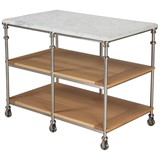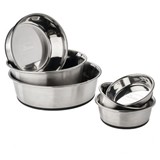Companies like Domino’s, which have invested heavily into convenient online delivery services and innovative features—such as driver tracking—have long outperformed the wider industry, according to IBISWorld.
However, the picture is not completely rosy. As third-party delivery services continue to grow, everyone—from the third-party operators, to the partner stores, to consumers—face risks. IBISWorld explores the threats and downsides of the third-party delivery wave.
Disrupting the Disruptors
The dawn of third-party delivery operators was met with great enthusiasm by investors. Menulog was acquired for $855 million by British delivery service Just Eat in May 2015.
“This was a whopping 371 multiple of its EBITDA, making it a very bullish acquisition,” said IBISWorld Senior Industry Analyst, Andrew Ledovskikh.
The business model was simple. The company provided an online advertising and order platform for small stores that couldn’t afford one. Menulog attracted consumers who were looking for somewhere they could compare multiple fast food options. Stores and consumers flocked to the site, leading to very positive statements from Just Eat in March 2016 about the ability to get a positive return on its acquisition.
Then, in August 2016, Uber Eats launched in Melbourne and Sydney. By October, it spread to most areas of Australia.
“The difference in Uber Eats’ model was that it provided delivery. Menulog was limited by the fact it could only provide services to stores with existing delivery staff and services,” said Mr. Ledovskikh.
“By March 2018, Just Eat slashed the value of Menulog by 40%. The company claimed this was a goodwill impairment to account for the cost of Menulog launching its own delivery service, rather than pressure from Uber Eats,” said Mr. Ledovskikh.
Regulatory Risk
Concerns over remuneration and conditions for third-party delivery drivers has been strong over the past five years. Multiple cases have challenged the contractor status of these drivers. Foodora being sued by the Fair Work Ombudsman over contractor status of third-party food delivery drivers is one example.
“This contractor status is vital to third-party operators, as it keeps costs down. It means these companies do not need to provide award wages, superannuation or benefits such as long service leave. Without the ability to employ these drivers as contractors, many third-party delivery operators would see their business model become unprofitable. This would see some operators collapse, while others would have to severely increase service charges to partner businesses,” said Mr. Ledovskikh.
IBISWorld forecasts the industry will face increased regulation on workers’ rights as the ‘gig economy’ becomes larger and more people are affected in Australia. As the contractor base of the ‘gig economy’ becomes larger the advocacy activities and protests we’ve seen in recent years are likely to become more prominent, and this will make the issue unavoidable.
“Over the next five years, the status of these workers will likely be defined through test court cases and decisive government policy. If these decisions don’t go the way of third-party delivery operators, it is very likely that the outlook for these companies will weaken,” said Mr. Ledovskikh.
Small businesses suffering
Many hospitality businesses jumped rapidly onto services liked Menulog and Uber Eats over the past five years, with Menulog boasting over 10,000 partner stores in 2018. According to IBISWorld, the number is jumping every year, despite rising commission charges following the company’s massive acquisition price.
Under the old Menulog model, businesses were charged 15% of the order value to pay for the cost of ordering from the service. Businesses that were provided delivery services by the third-party operator paid as much as 35%.
This is a significant sum, and many operators have complained that it makes them unprofitable. The simple solution of course is just not to use these services if you can’t afford it. However, the problem is the way that these operators have integrated themselves into the Fast Food and Takeway Food Services industry.
“When third-party services first launched, many small store owners jumped on because it gave them a competitive advantage against the store down the street, and provided them with better access to customers a suburb or two away. However, once every store on the street has the service, that competitive advantage begins to erode, and suddenly you’re just paying 5, 10, 15%, of your gross sales to Menulog or Uber Eats,” said Mr. Ledovskikh.
“Although in many ways third-party operators are providing a store with advertising, they are first and foremost advertising their service to consumers. As consumers become used to the service, if you leave, you lose those consumers. In effect many stores in Australia will feel they have been effectively franchised by third-party online operators.”
The Fast Food and Takeaway Food Services industry has already become increasingly competitive as consumer tastes have changed. With consumers now seeking premium takeaway options, many smaller traditional chicken, pizza, and fish and chips shops have struggled.
The large players have also not been immune. Pizza Hut has struggled to both make a profit and compete with their rival Domino’s.
“Pizza Hut jumped onto the Menulog service to try and boost its market share, after failing to do so via its own platform. Meanwhile, Red Rooster franchisees have complained in a submission to the Franchising Inquiry, alleging that the rollout of delivery services has cannibalized in-store sales and hurt profitability,” said Mr. Ledovskikh.
“Overall, the Fast Food and Takeaway Food Services industry has struggled to maintain profitability levels over the past five years, which is bad news for an industry where many of its players are already running on thin margins. Industry revenue growth is expected to be an annualised 0.7 % over the next five years,” said Mr. Ledovskikh.
Convenience costing consumers
While consumers are receiving the benefits of increased convenience through food-delivery services, they are increasingly paying higher prices for fast food and takeaway.
Additional delivery and the third-party commission fees built into the price of the food has meant strong growth in fast food prices paid by consumers, which in many cases is siphoned directly to third-party delivery operators.
“The pressure on third-party operators to ensure large investments pay off, and the possible increased costs to these operators if they lose regulatory battles surrounding contractor delivery drivers, will likely lead to consumers and small businesses facing higher charges over the next five years,” said Mr. Ledovskikh.
A February 2018 study by Finder.com.au, found that a third of all Australian adults living in capital cities were delivery-service users, and that their yearly average spend was almost $1,600.
“Small percentage increases to costs over the next five years could mean significantly more money spent by consumers. To put this into perspective, the Australian Energy Regulator recently announced it would strip $2.0 billion in revenue from electricity networks in a move aimed at saving Australians up to $30-$40 off their electricity bill every year. An added 2.5% gross sales commission on top of existing charges by third-party operators, passed on to consumers, would offset this entire saving. Following Just Eat’s acquisition of Menulog, the commission rose by 5%,” said Mr. Ledovskikh.
Want to comment on this topic? Click 'Have Your Say' and add your thoughts.













